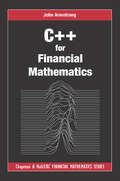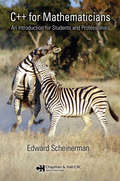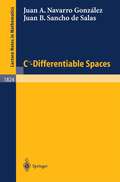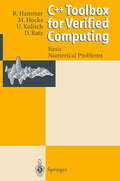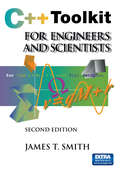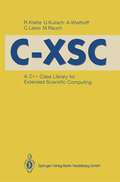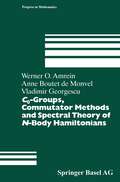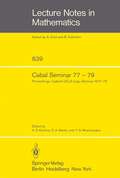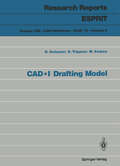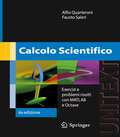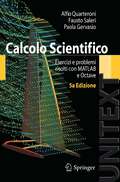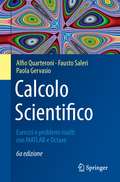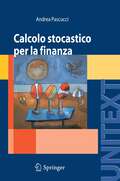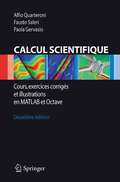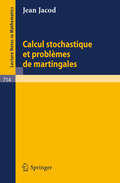- Table View
- List View
C++ for Financial Mathematics (Chapman and Hall/CRC Financial Mathematics Series)
by John ArmstrongIf you know a little bit about financial mathematics but don’t yet know a lot about programming, then C++ for Financial Mathematics is for you. C++ is an essential skill for many jobs in quantitative finance, but learning it can be a daunting prospect. This book gathers together everything you need to know to price derivatives in C++ without unnecessary complexities or technicalities. It leads the reader step-by-step from programming novice to writing a sophisticated and flexible financial mathematics library. At every step, each new idea is motivated and illustrated with concrete financial examples. As employers understand, there is more to programming than knowing a computer language. As well as covering the core language features of C++, this book teaches the skills needed to write truly high quality software. These include topics such as unit tests, debugging, design patterns and data structures. The book teaches everything you need to know to solve realistic financial problems in C++. It can be used for self-study or as a textbook for an advanced undergraduate or master’s level course.
C++ for Mathematicians: An Introduction for Students and Professionals
by Edward ScheinermanFor problems that require extensive computation, a C++ program can race through billions of examples faster than most other computing choices. C++ enables mathematicians of virtually any discipline to create programs to meet their needs quickly, and is available on most computer systems at no cost. C++ for Mathematicians: An Introduction for Stu
C^\infinity - Differentiable Spaces (Lecture Notes in Mathematics #1824)
by Juan A. Navarro González Juan B. Sancho de SalasThe volume develops the foundations of differential geometry so as to include finite-dimensional spaces with singularities and nilpotent functions, at the same level as is standard in the elementary theory of schemes and analytic spaces. The theory of differentiable spaces is developed to the point of providing a handy tool including arbitrary base changes (hence fibred products, intersections and fibres of morphisms), infinitesimal neighbourhoods, sheaves of relative differentials, quotients by actions of compact Lie groups and a theory of sheaves of Fréchet modules paralleling the useful theory of quasi-coherent sheaves on schemes. These notes fit naturally in the theory of C^\infinity-rings and C^\infinity-schemes, as well as in the framework of Spallek’s C^\infinity-standard differentiable spaces, and they require a certain familiarity with commutative algebra, sheaf theory, rings of differentiable functions and Fréchet spaces.
C++ Toolbox for Verified Computing I: Basic Numerical Problems Theory, Algorithms, and Programs
by Rolf Hammer Matthias Hocks Ulrich Kulisch Dietmar RatzOur aim in writing this book was to provide an extensive set of C++ programs for solving basic numerical problems with verification of the results. This C++ Toolbox for Verified Computing I is the C++ edition of the Numerical Toolbox for Verified Computing l. The programs of the original edition were written in PASCAL-XSC, a PASCAL eXtension for Scientific Computation. Since we published the first edition we have received many requests from readers and users of our tools for a version in C++. We take the view that C++ is growing in importance in the field of numeri cal computing. C++ includes C, but as a typed language and due to its modern concepts, it is superior to C. To obtain the degree of efficiency that PASCAL-XSC provides, we used the C-XSC library. C-XSC is a C++ class library for eXtended Scientific Computing. C++ and the C-XSC library are an adequate alternative to special XSC-Ianguages such as PASCAL-XSC or ACRITH-XSC. A shareware version of the C-XSC library and the sources of the toolbox programs are freely available via anonymous ftp or can be ordered against reimbursement of expenses. The programs of this book do not require a great deal of insight into the features of C++. Particularly, object oriented programming techniques are not required.
C++ Toolkit for Engineers and Scientists
by James T. SmithThis concise guide covers the fundamental aspects of the numerical analysis, basing upon it the construction of its routines for solving nonlinear equations, linear and nonlinear systems of equations, and eigenvalue problems. Focusing on software development, this book emphasizes software tools, OOP techniques for handling vectors, polynomials, and matrices. Using actual examples to demonstrate reusable tools, the book enables readers to solve broad classes of software development and programming challenges. It adopts a balanced approach between OOP techniques and quick and dirty number crunching, and emphasizes the use of OOP features in implementing vector, polynomial and matrix algebra. As a practical reference, it will help developers and consultants setting up applications programs for electrical, electronic engineering and physical sciences who need to develop clean, efficient C++ programs in minimal time.
C-XSC: A C++ Class Library for Extended Scientific Computing
by Rudi Klatte Ulrich Kulisch Andreas Wiethoff Christian Lawo Michael RauchC-XSC is a tool for the development of numerical algorithms delivering highly accurate and automatically verified results. It provides a large number of predefined numerical data types and operators. These types are implemented as C++ classes. Thus, C-XSC allows high-level programming of numerical applications in C and C++. The most important features of C-XSC are: real, complex, interval, and complex interval arithmetic; dynamic vectors and matrices; subarrays of vectors and matrices; dotprecision data types, predefined arithmetic operators with maximum accuracy; standard functions of high accuracy; multiple precision arithmetic and standard functions; rounding control for I/O data; error handling, and library of problem solving routines with automatic result verification. Thus, C-XSC makes the computer more powerful concerning the arithmetic. C-XSC is immediately usable by C programmers, easy to learn, user-extendable, and may also be combined with other tools. The book can be used as a textbook and as a reference manual. It consists of an introduction to advanced computer arithmetic, a chapter describing the programming languages C and C++, the major chapter "C-XSC Reference", sample programs, and indices.
C0-Groups, Commutator Methods and Spectral Theory of N-Body Hamiltonians (Progress in Mathematics #135)
by Werner Amrein Anne Boutet de Monvel Vladimir GeorgescuThe relevance of commutator methods in spectral and scattering theory has been known for a long time, and numerous interesting results have been ob tained by such methods. The reader may find a description and references in the books by Putnam [Pu], Reed-Simon [RS] and Baumgartel-Wollenberg [BW] for example. A new point of view emerged around 1979 with the work of E. Mourre in which the method of locally conjugate operators was introduced. His idea proved to be remarkably fruitful in establishing detailed spectral properties of N-body Hamiltonians. A problem that was considered extremely difficult be fore that time, the proof of the absence of a singularly continuous spectrum for such operators, was then solved in a rather straightforward manner (by E. Mourre himself for N = 3 and by P. Perry, 1. Sigal and B. Simon for general N). The Mourre estimate, which is the main input of the method, also has consequences concerning the behaviour of N-body systems at large times. A deeper study of such propagation properties allowed 1. Sigal and A. Soffer in 1985 to prove existence and completeness of wave operators for N-body systems with short range interactions without implicit conditions on the potentials (for N = 3, similar results were obtained before by means of purely time-dependent methods by V. Enss and by K. Sinha, M. Krishna and P. Muthuramalingam). Our interest in commutator methods was raised by the major achievements mentioned above.
C0-Groups, Commutator Methods and Spectral Theory of N-Body Hamiltonians (Modern Birkhäuser Classics)
by Werner O. Amrein Anne Boutet de Monvel Vladimir GeorgescuThe conjugate operator method is a powerful recently developed technique for studying spectral properties of self-adjoint operators. One of the purposes of this volume is to present a refinement of the original method due to Mourre leading to essentially optimal results in situations as varied as ordinary differential operators, pseudo-differential operators and N-body Schrödinger hamiltonians. Another topic is a new algebraic framework for the N-body problem allowing a simple and systematic treatment of large classes of many-channel hamiltonians. The monograph will be of interest to research mathematicians and mathematical physicists. The authors have made efforts to produce an essentially self-contained text, which makes it accessible to advanced students. Thus about one third of the book is devoted to the development of tools from functional analysis, in particular real interpolation theory for Banach spaces and functional calculus and Besov spaces associated with multi-parameter C0-groups. Certainly this monograph (containing a bibliography of 170 items) is a well-written contribution to this field which is suitable to stimulate further evolution of the theory. (Mathematical Reviews)
C2 Compiler Concepts
by Bernd Teufel Stephanie Schmidt Thomas TeufelWriting a compiler is a very good practice for learning how complex problems could be solved using methods from software engineering. It is extremely important to program rather carefully and exactly, because we have to remember that a compiler is a program which has to handle an input that is usually incorrect. Therefore, the compiler itself must be error-free. Referring to Niklaus Wirth, we postulate that the grammatical structure of a language must be reflected in the structure of the compiler. Thus, the complexity of a language determines the complexity of the compiler (cf. Compilerbau. B. G. Teubner Verlag, Stuttgart, 1986). This book is about the translation of programs written in a high level programming language into machine code. It deals with all the major aspects of compilation systems (including a lot of examples and exercises), and was outlined for a one session course on compilers. The book can be used both as a teacher's reference and as a student's text book. In contrast to some other books on that topic, this text is rather concentrated to the point. However, it treats all aspects which are necessary to understand how compilation systems will work. Chapter One gives an introductory survey of compilers. Different types of compilation systems are explained, a general compiler environment is shown, and the principle phases of a compiler are introduced in an informal way to sensitize the reader for the topic of compilers.
Cabal Seminar 76–77: Proceedings, Caltech-UCLA Logic Seminar 1976–77 (Lecture Notes in Mathematics #689)
by A. S. Kechris Y. N. MoschovakisCabal Seminar 77 – 79: Proceedings, Caltech-UCLA Logic Seminar 1977 – 79 (Lecture Notes in Mathematics #839)
by A. S. Kechris D. A. Martin Y. N. MoschovakisCABology: Value Of Cloud, Analytics And Big Data Trio Wave
by Nitin UpadhyayThis uniquely accessible book helps readers use CABology to solve real-world business problems and drive real competitive advantage. It provides reliable, concise information on the real benefits, usage and operationalization aspects of utilizing the “Trio Wave” of cloud, analytic and big data. Anyone who thinks that the game changing technology is slow paced needs to think again. This book opens readers’ eyes to the fact that the dynamics of global technology and business are changing. Moreover, it argues that businesses must transform themselves in alignment with the Trio Wave if they want to survive and excel in the future. CABology focuses on the art and science of optimizing the business goals to deliver true value and benefits to the customer through cloud, analytic and big data. It offers business of all sizes a structured and comprehensive way of discovering the real benefits, usage and operationalization aspects of utilizing the Trio Wave.
CAD Geometry Data Exchange Using STEP: Realisation of Interface Processors (Research Reports Esprit #1)
by Helmut J. HelpensteinThe Product Data Technology Advisory Group, short PDTAG, was established on 30 September 1992 under the auspices of the ESPRIT CIME Division of the Directorate General XIII of the European Commission. Its goals include promoting European cooperation and improving the European infrastructure in Product Data Technology, particularly in connection with the new standard STEP (ISO 10303). The dissemination of information on Product Data Technology and on European contributions to STEP is of crucial importance to this development. The current volume is the first title in a new PDTAG subseries to Springer Publishers' Research Reports ESPRIT. This new subseries intends to form a comprehensive repository of publications on Product Data Technology resulting from ESPRIT Projects and from European contributions to standardisation based on ISO/STEP. PDTAG welcomes the opportunity to make this information more accessible under the format of a coherent subseries within the established framework of Research Reports ESPRIT. Much valuable background on the new international PDT standard can thus be found in the same collection.
CAD*I Drafting Model (Research Reports Esprit #4)
by Richard Schuster Dietmar Trippner Michael EndresThe content of this book is an information model for technical drawings, the so-called "Drafting Model". The Drafting Model is a part of a complex information model describing product definition data, their applications and their representations. The definition of the information model is a central component of the development of STEP, a future international standard for the exchange of product defmition data. Here the Drafting Model particularly encloses descriptions for the representations of organizational drawing data, tolerances, dimensions and surface attributes such as surface fmish symbols (a survey of the whole content is shown in the figure above). Additional to that requirements for the Presentation Model concerning the representation of geometry as well as the integration process for both the Drafting and the Presentation Models are formulated. The extent of the Drafting Model is restricted to the application area "Mechanical Engineering". Within the Drafting Model the annotation representations are described on the one hand informally and on the other hand formally using a high level language for information modeling, EXPRESS. Principally the representations of the annotation are described according to the international drawing standards. Thus the semantics pertinent to the specific graphical appearance are maintained. The data structures provide formal descriptions of annotations at a high generation level, which means that a "way" is defmed how to generate these annotations.
Cake-Cutting Algorithms: Be Fair if You Can
by Jack Robertson William WebbThe challenge of dividing an asset fairly, from cakes to more important properties, is of great practical importance in many situations. Since the famous Polish school of mathematicians (Steinhaus, Banach, and Knaster) introduced and described algorithms for the fair division problem in the 1940s, the concept has been widely popularized. This book
Calabi-Yau Manifolds and Related Geometries: Lectures at a Summer School in Nordfjordeid, Norway, June 2001 (Universitext)
by Mark Gross Daniel Huybrechts Dominic JoyceThis is an introduction to a very active field of research, on the boundary between mathematics and physics. It is aimed at graduate students and researchers in geometry and string theory. Proofs or sketches are given for many important results. From the reviews: "An excellent introduction to current research in the geometry of Calabi-Yau manifolds, hyper-Kähler manifolds, exceptional holonomy and mirror symmetry....This is an excellent and useful book." --MATHEMATICAL REVIEWS
Calabi-Yau Varieties: Lecture Notes on Concentrated Graduate Courses (Fields Institute Monographs #34)
by Radu Laza Matthias Schütt Noriko YuiThis volume presents a lively introduction to the rapidly developing and vast research areas surrounding Calabi–Yau varieties and string theory. With its coverage of the various perspectives of a wide area of topics such as Hodge theory, Gross–Siebert program, moduli problems, toric approach, and arithmetic aspects, the book gives a comprehensive overview of the current streams of mathematical research in the area.The contributions in this book are based on lectures that took place during workshops with the following thematic titles: “Modular Forms Around String Theory,” “Enumerative Geometry and Calabi–Yau Varieties,” “Physics Around Mirror Symmetry,” “Hodge Theory in String Theory.” The book is ideal for graduate students and researchers learning about Calabi–Yau varieties as well as physics students and string theorists who wish to learn the mathematics behind these varieties.
The Calabi–Yau Landscape: From Geometry, to Physics, to Machine Learning (Lecture Notes in Mathematics #2293)
by Yang-Hui HeCan artificial intelligence learn mathematics? The question is at the heart of this original monograph bringing together theoretical physics, modern geometry, and data science. The study of Calabi–Yau manifolds lies at an exciting intersection between physics and mathematics. Recently, there has been much activity in applying machine learning to solve otherwise intractable problems, to conjecture new formulae, or to understand the underlying structure of mathematics. In this book, insights from string and quantum field theory are combined with powerful techniques from complex and algebraic geometry, then translated into algorithms with the ultimate aim of deriving new information about Calabi–Yau manifolds. While the motivation comes from mathematical physics, the techniques are purely mathematical and the theme is that of explicit calculations. The reader is guided through the theory and provided with explicit computer code in standard software such as SageMath, Python and Mathematica to gain hands-on experience in applications of artificial intelligence to geometry. Driven by data and written in an informal style, The Calabi–Yau Landscape makes cutting-edge topics in mathematical physics, geometry and machine learning readily accessible to graduate students and beyond. The overriding ambition is to introduce some modern mathematics to the physicist, some modern physics to the mathematician, and machine learning to both.
Calcolo scientifico: Esercizi e problemi risolti con MATLAB e Octave (UNITEXT)
by Alfio Quarteroni F. SaleriQuesto testo è espressamente concepito per i corsi brevi del nuovo ordinamento delle Facoltà di Ingegneria e di Scienze. Esso affronta tutti gli argomenti tipici della Matematica Numerica, spaziando dal problema di approssimare una funzione, al calcolo dei suoi zeri, delle sue derivate e del suo integrale definito fino alla risoluzione approssimata di equazioni differenziali ordinarie e di problemi ai limiti. Due capitoli sono inoltre dedicati alla risoluzione di sistemi lineari ed al calcolo degli autovalori di una matrice, mentre un capitolo iniziale conduce lo studente ad un rapido ripasso degli argomenti dell'Analisi Matematica di uso frequente nel volume e ad una introduzione al linguaggio Matlab. I vari argomenti sono volutamente affrontati a livello elementare ed i paragrafi che richiedono maggior impegno sono stati opportunamente contrassegnati. In questa quarta edizione il linguaggio Octave (di distribuzione gratuita) si affianca a MATLAB.
Calcolo Scientifico: Esercizi e problemi risolti con MATLAB e Octave (UNITEXT)
by Alfio Quarteroni F. Saleri Paola GervasioQuesto testo è concepito per i corsi delle Facoltà di Ingegneria e di Scienze. Esso affronta tutti gli argomenti tipici della Matematica Numerica, spaziando dal problema di approssimare una funzione, al calcolo dei suoi zeri, dei suoi minimi, delle sue derivate e del suo integrale definito fino alla risoluzione di sistemi lineari e non lineari, di equazioni differenziali ordinarie e alle derivate parziali con metodi alle differenze finite e agli elementi finiti. Un capitolo iniziale conduce lo studente ad un rapido ripasso degli argomenti dell'Analisi Matematica di uso frequente nel volume e ad una introduzione ai linguaggi MATLAB e Octave. Al fine di rendere maggiormente incisiva la presentazione e fornire un riscontro quantitativo immediato alla teoria vengono implementati in linguaggio MATLAB e Octave tutti gli algoritmi che via via si introducono. Vengono inoltre proposti numerosi esercizi, tutti risolti per esteso, ed esempi, anche con riferimento ad applicazioni negli ambiti piu' svariati.
Calcolo Scientifico: Esercizi e problemi risolti con MATLAB e Octave (UNITEXT #105)
by Alfio Quarteroni Fausto Saleri Paola GervasioQuesto testo è concepito per i corsi delle Facoltà di Ingegneria e di Scienze. Esso affronta tutti gli argomenti tipici della Matematica Numerica, spaziando dal problema di risolvere sistemi di equazioni lineari e non lineari a quello di approssimare una funzione, di calcolare i suoi minimi, le sue derivate ed il suo integrale definito fino alla risoluzione di equazioni differenziali ordinarie e alle derivate parziali con metodi alle differenze finite ed agli elementi finiti. Un capitolo iniziale conduce lo studente ad un rapido ripasso degli argomenti dell'Analisi Matematica e dell'Algebra Lineare di uso frequente nel volume e ad una introduzione ai linguaggi MATLAB e Octave. Al fine di rendere maggiormente incisiva la presentazione e fornire un riscontro quantitativo immediato alla teoria vengono implementati in linguaggio MATLAB e Octave tutti gli algoritmi che via via si introducono. Vengono inoltre proposti numerosi esercizi, tutti risolti per esteso, ed esempi, anche con riferimento ad applicazioni in vari ambiti scientifici. Questa sesta edizione si differenzia dalle precedenti per l’aggiunta di nuovi sviluppi, di nuovi esempi relativi ad applicazioni di interesse reale e di svariati esercizi con relative soluzioni.
Calcolo stocastico per la finanza (UNITEXT)
by Andrea PascucciQuesto testo propone un’introduzione ai metodi matematici, probabilistici e numerici che sono alla base dei modelli per la valutazione degli strumenti derivati, come opzioni e futures, trattati nei moderni mercati finanziari. Il libro è rivolto a lettori con formazione scientifica, desiderosi di sviluppare competenze nell’ambito del calcolo stocastico applicato alla finanza. La prima parte è dedicata ad una presentazione dei modelli per i mercati in tempo discreto in cui le idee sui principi di valutazione sono illustrate in modo semplice e intuitivo. Contemporaneamente sono forniti gli elementi di base della teoria della probabilità. Successivamente la teoria dell’integrazione e del calcolo stocastico in tempo continuo viene sviluppata in maniera rigorosa ma, per quanto possibile, snella. Viene posta una particolare enfasi sui legami fra la teoria delle equazioni differenziali stocastiche e degli operatori alle derivate parziali di evoluzione. Il classico modello di Black&Scholes viene analizzato in dettaglio sia con un approccio analitico, sia nell’ambito della teoria delle martingale. La trattazione punta ad essere chiara e rigorosa piuttosto che onnicomprensiva, proponendo una comprensione approfondita del problema della valutazione e copertura di opzioni Call e Put come punto di partenza per l’affronto di strumenti derivati esotici. Data la loro importanza vengono studiate le opzioni di tipo Americano e alcuni tra i più noti derivati "path-dependent" come le opzioni Asiatiche e con barriera. Un capitolo è dedicato ad illustrare i più noti modelli di volatilità stocastica che generalizzano l’analisi di Black&Scholes. Infine la teoria precedente è accompagnata dalla descrizione dei principali metodi numerici per la valutazione di opzioni: il metodo Monte Carlo, gli alberi binomiali, i metodi alle differenze finite.
Calcul Scientifique: Cours, exercices corrigés et illustrations en Matlab et Octave
by Alfio Quarteroni Fausto Saleri Paola GervasioCe livre constitue une introduction au Calcul Scientifique. Son objectif est de présenter des méthodes numériques permettant de résoudre avec un ordinateur certains problèmes mathématiques qui ne peuvent être traités simplement avec un papier et un crayon. Les questions classiques du Calcul Scientifique sont abordées: la recherche des zéros ou le calcul d'intégrales de fonctions continues, la résolution de systèmes linéaires, l'approximation de fonctions par des polynômes, la résolution approchée d'équations différentielles. La présentation de ces méthodes est rendue vivante par le recours systématique aux environnements de programmation Matlab et Octave dont les principales commandes sont introduites progressivement. Tous les algorithmes sont présentés sous la forme de programmes. Ceci permet de vérifier très rapidement leurs propriétés théoriques, en particulier la stabilité, la précision et la complexité. La résolution de divers problèmes, souvent motivés par des applications concrètes, fait l'objet de nombreux exemples et exercices. À la fin de chaque chapitre, une section présente des aspects plus avancés et fournit des indications bibliographiques qui permettront au lecteur d'appronfondir les connaissances acquises. Le dernier chapitre est consacré à la correction des exercices proposés tout au long du livre
Calculator Calculus
by G. MccartyHow THIS BOOK DIFFERS This book is about the calculus. What distinguishes it, however, from other books is that it uses the pocket calculator to illustrate the theory. A computation that requires hours of labor when done by hand with tables is quite inappropriate as an example or exercise in a beginning calculus course. But that same computation can become a delicate illustration of the theory when the student does it in seconds on his calculator. t Furthermore, the student's own personal involvement and easy accomplishment give hi~ reassurance and en couragement. The machine is like a microscope, and its magnification is a hundred millionfold. We shall be interested in limits, and no stage of numerical approximation proves anything about the limit. However, the derivative of fex) = 67.SgX, for instance, acquires real meaning when a student first appreciates its values as numbers, as limits of 10 100 1000 t A quick example is 1.1 , 1.01 , 1.001 , •••• Another example is t = 0.1, 0.01, in the function e/3t+9-3)/t. ix difference quotients of numbers, rather than as values of a function that is itself the result of abstract manipulation.
